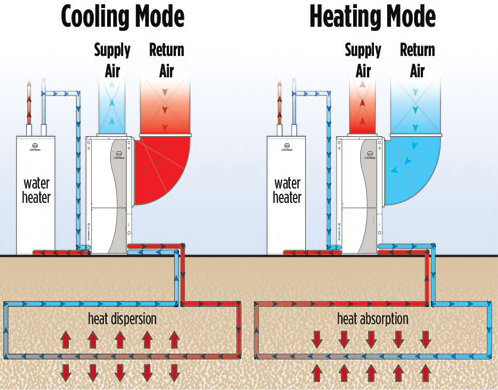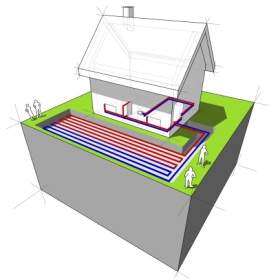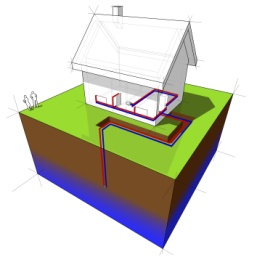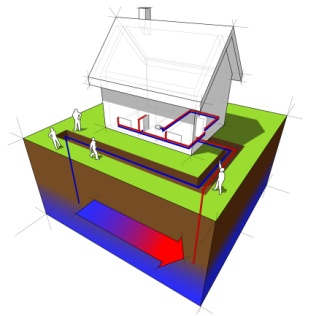What They Are and How They Work
Geothermal heating and cooling systems use the heat of the earth to both heat and cool your home. In Maryland the ground temperature stays at a constant 55 oF year round, which provides a nearly optimal temperature for this equipment to efficiently heat and cool a home. During the summer months the heat taken out of the air in your house is transferred to the ground. The process works in reverse during the winter months, transferring the heat of the ground to the house.
Geothermal systems are heat pumps, but unlike a traditional heat pump, this system uses a combination of a multistage compressora and a variable speed fan to provide a constant level of comfort to the home. The cost savings are immediately noticed because your heating and cooling processes start with air at 55 degrees as opposed to the ambient air temperature. Once the desired temperature is reached, the system will keep it at that temperature and you won’t notice any air movement.
A geothermal system uses the fact that heat travels towards cold to transfer the earth’s naturally occurring temperature to a working fluid (glycol). To perform this heat transfer, geothermal systems use piping buried in your yard, installed vertically in wells, or submerged in a nearby pond to allow this heat transfer to take place. For every ton of capacity, the system will need 150 feet of pipe. If your system is a 3 ton system, you would need 450 of pipe to operate it.
The illustration below demonstrates how the heat is transferred to and from the earth.
[1]A multistage compressor runs at two speeds, a slower speed when there is less demand on the system and at full speed when demand is high. This makes the system more efficient because the slower speed uses less energy. Most of the time, the system will run in the slower speed.

Image courtesy of Water Furnace®
What makes a geothermal system so efficient is: 1) the earth’s constant 55 oF temperature to do the thermal exchange, 2) it uses a liquid to do the thermal exchange instead of air, and 3) it rarely needs the electric resistant backup heat.
There are several types of geothermal systems allowable in Maryland; more details and diagrams of these are available at the U.S. Department of Energy’s (DOE) web page on Geothermal Heat Pumps.

- Horizontal closed-loop systems may be most cost-effective for residential installations, especially for new construction where sufficient land is available. It requires trenches at least four feet deep.
- Pond closed-loop systems can be the lowest cost option. They take advantage of nearby bodies of water into which coiled supply lines are placed at least eight feet under the surface.

- Vertical closed-loop systems are better where there is little available land or where soil is too shallow for trenching. Holes, approximately four inches in diameter, are drilled about 20 feet apart and 100 to 400 feet deep. This type of system minimizes disturbance to existing landscaping.

- Open-loop systems use well or surface body water as the heat exchange fluid that circulates directly through the geothermal system. After water has circulated through the system, it returns to the ground through the well, a recharge well, or surface discharge. Because they are built like a normal residential water well, open loop systems garner further regulatory review. While they require additional permitting, the efficiency benefits outweigh the extra oversight.
The following chart shows a cost comparison to generate 100Kb BTUsc of usable heat using different heat sources. (100K BTUs is about 80% of the energy in a gallon of gasoline, or in a little more than 8 pounds of coal.)
Cost Comparisons to Generate 100K BTUs of Usable Heat
|
Method |
BTUs |
Per |
Usable |
Units required to 100K |
Unit price |
Cost for 100K |
|
Geothermal, 30 EER[4] |
18,783 |
Kwh |
100% |
5.3241 |
$0.111 |
$0.59 |
|
Heat Pump, 16 SEER[5] |
9,391 |
Kwh |
100% |
10.6482 |
$0.111 |
$1.19 |
|
Heat Pump, 13 SEER |
7,630 |
Kwh |
100% |
13.1055 |
$0.111 |
$1.46 |
|
Wood Pellets |
8,250 |
Pound |
80% |
15.1515 |
$0.116 |
$1.75 |
|
Natural Gas |
100,000 |
Therm |
80% |
1.2500 |
$1.400 |
$1.75 |
|
Electric |
3,415 |
Kwh |
100% |
29.2826 |
$0.111 |
$3.26 |
|
Propane |
84,000 |
Gallon |
96% |
1.2401 |
$2.862 |
$3.55 |
|
Oil |
95,000 |
Gallon |
80% |
1.3158 |
$3.650 |
$4.80 |
[2]100K – Shortcut for 100,000
[3] British Thermal Unit (BTU) is a measure of heat energy. Electric baseboard heat generates 3,415 BTUs per kilowatt of energy.
[4] EER – Energy Efficiency Ratio
[5] SEER - Seasonal Energy Efficiency Ratio
Geothermal systems also can supply a limited amount of hot water. Excess heat from the compressor can be transferred to a hot water heater. During the winter heating season and summer cooling season, this can significantly reduce the amount of hot water you would need to create using traditional means.
Benefits
In addition to energy saving and utility bill reductions, geothermal systems have other benefits (Source).
- Quiet: Geothermal heat pumps do not have outside condensing units like traditional heat pumps or air conditioners, so there's no concern about noise outside the home or the unit being vandalized. A two-speed system is so quiet inside that residents usually do not know it is operating
- Small Space Requirements: Hardware for geothermal systems requires less space than a conventional HVAC system, so the equipment rooms can be greatly scaled down, freeing space for productive uses.
- Zone Conditioning: Geothermal systems allow different parts of your home to be heated or cooled to different temperatures.
- Reliability: Geothermal systems have relatively few moving parts. All the equipment is self contained in the base of the air handler which is sheltered inside a building and is easily accessible for upkeep.
- Durability: Few moving parts, sheltered equipment, and underground piping, which often carry warranties of 25 to 50 years, mean that geothermal heat pumps are durable. Inside components last 25 years or more and the ground look may last 50 or more years.
Understanding the Incentives
The Information below on incentives is current as of January 2013. For the most up to date information on incentives, visit www.DSIREUSA.org.
- State Grant: The Maryland Clean Energy Grant Program currently offers a flat grant of $3,000 for the installation of a 1 tonb to 10 ton geothermal system for a residence.
- Federal Investment Tax Credit: Under current law, geothermal systems installed on residences or businesses prior to December 31, 2016 are eligible for a 30% federal tax credit. A homeowner who installs a $25,000 (after incentives) system could reduce their tax obligation by $7,500 for the tax year in which the system is installed. If the credit is larger than their tax bill in the year of installation, the remainder of the credit can be carried forward to future years.
- Renewable Energy Credits (RECs): In 2012 the Maryland legislature passed a law that makes geothermal heat pumps an accepted technology available for Renewable Energy Credits. After the law goes into effect in 2013, homeowners with new geothermal systems will be eligible to receive Renewable Energy Credits (RECs). Check www.DSIREUSA.org for updates.
[6] Ton – is a measure of capacity of and HVAC system. 1 ton equals 12,000 BTUs of heat.
|
Pro-Formas*: |
2 kW |
4kW |
8kW |
10kW |
|
Installed Cost of System[7] |
$19,000 |
$22,000 |
$27,000 |
$30,000 |
|
Maryland State Grant |
$3,000 |
$3,000 |
$3,000 |
$3,000 |
|
Federal Tax Credit |
$5,700 |
$6,600 |
$8,100 |
$9,000 |
|
Sale of Renewable Energy Credits (RECs)[8] |
$100 |
$400 |
$800 |
$1,000 |
|
Electricity Savings in 1st Year[9] |
$1,400 |
$2,800 |
$5,600 |
$7,000 |
|
Total Grants, Credits, and Savings in 1st Year: |
$10,200 |
$12,800 |
$17,500 |
$20,000 |
|
Net Cost to System Owner at end of 1st Year: |
$8,800 |
$9,200 |
$9,500 |
$10,000 |
|
Years 2-6 Electricity Savings and REC Revenues: |
$7,500 |
$16,000 |
$32,000 |
$40,000 |
|
Net Cost to System Owner at end of Year 6 |
$1,300 |
-$6,800 |
-$22,500 |
-$30,000 |
|
Years to payoff investment |
6.87 |
3.88 |
2.48 |
2.25 |
*For illustrative purposes only. A Pro-forma is assumed, forecasted, or informal information. It gives an idea of how the actual finances may look if underlying assumptions hold true. Actual costs and incentives depend upon site conditions and programs that are applicable to your situation. These pro-formas are not guaranteed and are subject to change without notice. Pro-forma provided by David Barrow.[7] Cost estimated with the installation of horizontal ground loop. If you choose to install vertical ground loops, the cost for installation will be higher; however, you can include the additional cost in the total cost when requesting the federal tax credit.
[8] REC – Renewable Energy Credit estimated value of $100 per ton (awaiting Public Service Commission determination of value).
[9] Savings estimates compare a geothermal system to a heat pump with a propane backup.
Paying for a Geothermal System
A geothermal system is a major investment. In a typical home of 2,500 square feet, a geothermal system may cost $20,000 - $25,000 to install. While this is roughly double the cost of a conventional heating, cooling, and hot water system, geothermal heating/cooling systems can reduce utility bills by 40% to 60%. According to DOE’s web page on Choosing and Installing a Geothermal Heat Pump, you may recoup your initial investment in two to ten years through lower utility bills depending on factors such as climate, soil conditions, the system features you choose, and available financing and incentives. When included in a mortgage, your investment in a geothermal system will produce a positive cash flow from the beginning. For example, if the extra $3,500 cost of the system will add $30 per month to your mortgage payment, the energy cost savings will easily exceed that added mortgage amount over the course of each year.
Grant and tax credit money will typically cover 40% of the total cost of the system, however in some cases it may take up to a year to get that money. Most installers will offer a 0% loan for up to 12 months on part or all of your cost; therefore, you can recover the grant and credit money. The remainder can then be paid out of pocket or be financed thru a bank, credit union, home equity loan, or the Maryland Be SMART Home Complete loan program. As of 2013, the Be SMART Home Complete loan program was offering up to $15,000 in unsecured loans at an interest rate of 4.99%. This program includes a home energy audit and does require using the program’s approved contractors. They have a limited number of contractors for renewable energy systems; however, contractors can be added on a rolling basis. In addition, the FHA's allows eligible owners to borrow up to $25,000 at fixed rates to finance energy efficiency projects and renewable energy projects like geothermal systems.
A few companies also offer financing plans that cover the upfront cost of installing a geothermal ground loop and more. Similar to solar system leases, “geothermal leases” enable a homeowner to install a geothermal ground loop without finding a contractor, paying the upfront installation cost, or contracting for subsequent maintenance or repair. Instead, these companies handle system installation, maintenance, and other associated costs. Property owners make monthly payments on multi-year financing plans. Enter “no money down geothermal” into your internet browser to find companies offering this type of financing plan for geothermal systems.
Deciding if Geothermal HVAC is Right for You
A geothermal system makes the most sense if you can answer yes to the following questions:
- Do you own your house and expect to remain there for a minimum of 5 years?
- Are you comfortable making a financial investment of over $20,000, or willing to apply for a loan or other financing?
- Do you have enough land to support the piping necessary?
a. For a horizontal installation, you will need a minimum of 1 acre of land.
b. For a vertical installation, you will need a minimum of 1/4 acre as long as you have access to a location where large well drilling equipment can access it.
- Can you continue to use your existing equipment for up to 45 days while you go through the permit process and installation of the equipment?
A negative answer question does not necessarily mean that a geothermal system is inappropriate for a property. It does suggest that it may be more difficult to maximize the value of the system or limit the financial benefits.
Installation: Requirements and Expectations
It is always a good idea to get assessments and estimates from more than one contractor. Read Contractor Selection Tips and Resources to find and assess prospective installers. Based on the specific geological, hydrological, and spatial characteristics of your land, installers will determine the best type of ground loop for your site. It is strongly recommended that you consider an energy audit of your structure prior to installation. Just designing based on the current square footage without taking into consideration how “leaky” your structure is, may cause your system to become overloaded at temperature extremes or become less efficient over time.
The following steps will need to be performed to install a geothermal system. Every contractor is different; some apply for and pay for the permits on your behalf and roll costs into the contract, while others require you to apply for permits and call in inspections. Be sure to ask your contractor about this before your sign a contract.
- Apply for a well permit for vertical installation or an excavation permit for horizontal installation (2 weeks).
- Apply for electrical permit to install new circuits for equipment (2 weeks; can be done at same time as step 1 above).
- Drill well(s) and/or dig trenches and install all the piping (1 to 2 weeks).
- Remove existing equipment and install geothermal equipment and replacement duct hood (2 to 3 days).
- Final electrical inspection (1 day).
The total time needed for installation from beginning to end is approximately 4½ weeks.
The only maintenance needed for the system is replacement of the furnace filter every 6 months. The homeowner can choose to buy a preventative maintenance package from the installer where they will change the filter and inspect the system, lubricate moving parts and visibly inspect other parts of the system.
Contributors: David Barrow, Green Ambassador; John Boris, Jr., Maryland Department of the Environment